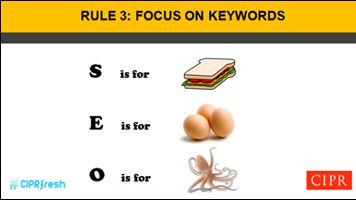
Blog post -
Sandwich, Eggs, Octopus: The Secret to Digital PR
Guest post by Paul Sutton, Head of Social Communications, BOTTLE PR
I was recently invited to run a training session on "Writing for Digital Media" for the Chartered Institute of Public Relations as part of the CIPR Freshly Squeezed series. Among my supposed words of wisdom about the differences in tone, style and approach between print and digital media, there was one point that I wanted to try and drive home more than any other: that of how important it is for PRs to gain an understanding of search engine optimisation (SEO).
SEO is a huge and very technical area; one that changes continuously as Google tweaks and updates its algorithms. And with the advent of Google Instant, social search and personalised search results from add-on tools such as Wajam, it's a discipline that few but the most dedicated PRs will ever have a detailed and up-to-date understanding of.
Everyone writing for digital media needs to know the basics of SEO and how to optimise news releases and blog posts, so to really drum this into people's heads last week and hopefully to make them remember the point, I decided to illustrate my words with some images you wouldn’t expect to see when talking about search engine optimisation: S is for sandwich, E is for eggs, O is for octopus.
What’s ironic, however, is that using the phrase "sandwich, eggs, octopus" in the title of this post rather than "search engine optimisation" is a perfect (if rather childish) example of what many people writing for digital media and using services such as Mynewsdesk do every time they post an article. They fail to think about what Google considers important in the SERPs. And as I was at pains to point out to the room full of bemused looking PRs staring at a cartoon drawing of an octopus last week, Google loves title and H1 tags. These tags help the worlds of SEO and PR come together in blissful harmony.
For the uninitiated, a title tag is a short piece of code which looks like <title> and an H1 tag looks like this: <h1>. These tags surround your page title and key heading, and tell Google that the words contained within it are what the article is about. So making those words as relevant as possible to your article topic is of paramount importance. For this reason, calling an article about search engine optimisation "sandwich, eggs, octopus" will confuse the hell out of the search engine spiders, resulting in poor listings in the SERPs (sorry, Mynewsdesk).
H1 tags and page titles are only one element of basic on-page SEO that people writing for digital media should understand, however. Using relevant keywords and keyword phrases in body copy, URLs, anchor text (text that hyperlinks to other sources) and ALT tags (the text descriptions of images, for example) is not only good practice, it’s something that every PR should know how to do and be doing on a regular basis.
As I alluded to earlier, SEO is a complex field. But my advice would be to read and skill up on the basics and to understand where and why you, as a digital content creator, can make an impact.
Paul Sutton is Head of Social Communications at Oxford-based PR agency BOTTLE, recently named Outstanding Consultancy of the Year by the CIPR (Thames & Chiltern). Paul is responsible for devising creative social media strategies and ensuring that account teams make them work across the board to meet commercial client objectives. He blogs at The Social Web and can be found on Twitter as @ThePaulSutton.

